 | The practice of yoga means asanas and breathing practices to many but it has many other aspects to learn about. The Science of Yoga mudra is all dependent on the Pancha Bhoota or Pancha Maha-Bhoota. Pancha Maha-Bhoota or five physical elements(cosmic elements) is a group of five essential elements, which, according to Vedas, is the basis of all universal creation. Reference Reading :YogaHome | YogaGyan | Yogasan | YogaMore | YogaSutra | YogaFor | ShatKarma |
According to the ancient tantric text “Kularnava Tantra”, the word ‘mudra‘ is derived from two Sanskrit words mudam and drava.
mudam means ‘bliss’ or ‘happiness’ and ‘drava‘ means ‘to draw forth’. It implies that mudras have the power to bring forth the hidden joy or happiness that lies within us.
According to Ayurveda and Yoga, the human body is considered to be made up of these five elements.
Pancha Bhootas are connected with the overall well-being of the human being. Any dysfunction or sickness in the human body indicates an imbalance of one or more of these elements. These 5 elements are associated to 5 fingers of human hand. The use of Mudras adjusts the flow of energy – affecting the balance of air, fire, water, earth, either. In ancient times, the sages used to perform yoga mudras to keep the five elements inside the body balanced with air, water, fire, earth, and sky.
Different Mudras were developed to balance these in the human body,
which forms the Hasta Mudra in yogic tradition. These Hasta Mudras are
also used in Naturopathy. These five elements are: Prithvi/Bhudevi (Earth), Apas/Varuna/Jal (Water), Agni (Fire), Vayu (Air), Aakasha/Dyaus (Aether) The Pancha-mahabhootas and their associated organs and factors, beejamantra Thumb - Fire (seeing) (eyes, navel) - ram Index - Air (touch) (skin, heart) - yam Middle Finger - Ether(sound) (ears, throat) - ham, kham Ring Finger - Earth (smell) (nose) - lam Last Finger- Water (taste) (tongue, sacral) - vam | 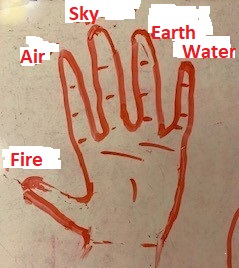 |
ॐ नमः शिवाय:
Om Namah Shivaya is Panchakshari mantra excluding Omkar (primary cosmic vibration).
Namah Shivaya attached with the five essential elements of the materialistic world NA – MA -SI – VA – YA.
Na-Earth Element (Prithvi Tattva) , Ma-Water Element (Jal Tattva), Si-Fire element (Agni Tattva), Va-Air element (Vayu Tattva),
Ya-Space element (Akasha Tattva)
Many hindu people chant this mantra and those particular yogis have connected themselves with the primary nature of the existence which is Prakriti or sublime energy flow. Goddess Shakti resides in that energy flow and takes you to the Shiva.
It is a remarkable ancient science of Yogis based on logistic realities. If chanted correctly, mantra helps chanter to get connected with Lord Shiva. Connecting to Shiva means going to self-healing mode.
Mudra
Mudras are special, unique energetic flows that take our consciousness to a higher level. Many are done with the hands and fingers but there are lots of other mudras that involve the whole body. They are meant to create pranic flows in very specific ways that prepare the practitioners for the ultimate stage of Hatha Yoga. All these advance Mudra practice to be learned from trained yoga teacher(Guru).
As per upanishada reference each person has five distinct energy bodies (sheath) or koshas, vibrating at different speeds. These interacting and overlapping layers of energy form the complete spiritual, mental and physical nature of the human personality.Each kosha signifies a more refined dimension of consciousness. The koshas are known as annamaya, pranamaya, manomaya, vijnanamaya and anandamaya. Pranamaya kosha is made up of five major pranas, which are collectively known as the panchaprana. the practice of making mudras links all these together. Mudra's chanelise the energy (prana) to remain within our body instead of letting go out.
Mudras can be classified into the five basic categories. The categories are yogic, spiritual, curative, religious, and customary.
We are explaiing Mudras in brief rerlated to Hatha Yoga which includes Asanas, Pranayama, Shatkriyas, Bandhas and Mudras. Many of the Yoga texts take Bandhas and Mudras as a single unit.
According to Gheranda Samhita, there are mainly 25 Mudras, whereas Hatha Pradipika describes only 10 of these. Among them the following twelve are the most important ones:
MahaVedh, MahaMudra (internal (aantarik) kumbhak (holding the breath)), MahaBandha,
Uddyan Bandh ( internal(aantarik), External(bahya) ), Mul Bandh (internal (aantarik)), Jalandar Bandh,
Viprit Karni -Mul Badha, Shakti Chalan, Khechari, Vajroli.
Other two Mudras : Yoni Mudra, Yoga Mudra
Hathapradipika describes 10 main Mudras, excluding Yoga Mudra and Yoni Mudra, from the above mentioned list of 12 Mudras. There are various minor Mudras too, which are prevent and practiced by the Hatha Yogis.
Four Common Mudras:
Asvini Mudra, Maha Mudra, Shanmukhi Mudra, Yoga Mudra
Other minor Mudras:
Chin, Chinmay, Adi, Bramha, Shambavi, Unmani
Hasta Mudras
Few Hasta Mudras are listed below for refrences:
Hasta Mudras can be practiced in any stable seated posture such as sukhasana (easy pose) or padmasana (lotus pose), in which the spine can remain upright.
| Mudra | Purpose | How to | Pose |
| Dhyan | Meditation | Dhyana mudra is a sacred hand gesture or 'seal,' used during yoga and meditation practice as a means of channeling the flow of vital life force energy known as prana. ... It is performed by resting the right hand on top of the left, palms facing up and the thumbs slightly lifted so that the tips touch one another |  |
| Nasika/Vishnu | Anulom Vilom | This Mudra is usually adapted for the practice of Pranayama. Index and middle finger of the right hand are usually closed. Use right thumb to close the right nostril and little and ring finger to close the left nostril. | 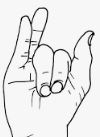 |
| Hakini | Enhance
concentration |
First bring the palms to face one another a few inches apart. Bring the fingertips and thumbs of both hands together, allowing them to maintain light contact. The hands can then be raised to the level of the third-eye chakra, in the center of the forehead. In order to enhance the benefits of this mudra, the drishti (gaze) should be lifted towards the third-eye. Additionally, whilst breathing through the nostrils, the tongue should be placed against the roof of the mouth with each inhalation, and relaxed with each exhalation. | 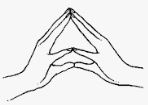 |
| Prithvi | Healing and mental stability (4am to 6am) | You have to bring the ring finger and the thumb closer where slight pressure from ring to tip of thumb. | 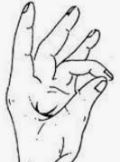 |
| Akash | Spiritual, mental and emotional benefits | You have to bring
the middle finger and the thumb closer where slight pressure from ring to
tip of thumb. migraine, sinusitis, gains consciousness, Hearing power improves, activates the visuddha (throat) chakra, increases calcium in the body, removing negative emotions like anger, sorrow or fear, detoxifies the body, panacea for mentally and physically challenged children | 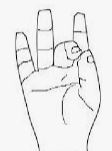 |
| Pran | It makes body & mind stable and reduces muscle pain, improves immunity & vision. During fastig this practice will benifits more. | You have to bring the ring finger, litle finger and the thumb closer where slight pressure to put on joining fingers. |  |
| Apan | Akash Mudra cures all diseases relating to the heart, lungs, ear and throat while Prithvi Mudra gives strength to the body and removes all vitamin/mineral deficiencies | In this mudra, two mudras are formed together viz. Prithvi Mudra and Akash Mudra – joining of three elements, namely fire, space and earth. |  |
| Vayu | Enhance stomach health, reduce pain, improve mental well-being and overcome hormonal balance. Opens the airways, tones the large intestine. | Now fold your index finger and press it with your thumb. Rest of the three fingers should be kept extended. |  |
| Surya | To Treat obesity, overweight, high choesterol. If perform after SN, Pran mudra helps for vision improvments. | Fold your ring finger such a way tht it touches the root of thumb. Not to practice when ou are weak. |  |
| Mushthi | Relieves negative emotions such as anger, fear and frustration Eases constipation, Lowers blood pressure |
Each hand makes a fist and the thumb stretches over the first three fingers to touch the ring finger. |  |
| Bhairav | Maintains equilibrium between your left and right portion of your brain. minimize the opposing forces to a very great extent. | You simply need to bring both your hands out and place your right hand on the top of your left hand. Now, there are two major variations of this exercise. When you place your right hand on top it is known as bhairava mudra and when you place your left hand on top it is called bhairavi mudra. |  |
| Vajra | Stimulates blood circulation in the body. It prevents low blood pressure diseases like dizziness, weakness in our body. | Now fold your small, middle and ring fingers
and tap the tips of these fingers to the tip of the thumb. The rest of
the index finger should be keep extended as much as possible. It
strengthens the immune system also. When Vajra Mudra practiced regularly, it will increase memory power and sharpens the brain. |  |
| Kali | For healing symptoms related to anxiety, depression, or insomnia. | This mudra is also referred to as Ksepana Mudra which is a gesture of pouring out and letting go. While preforming this practice, blockages in the Sushumna Nadi are relived which encourages positivity within the body. Interlace the middle, ring and pinky fingers. The index fingers are together and pointing up. Cross the left thumb over the right thumb. Bring the elbows against the torso with the fingers pointing in front of you. | 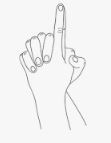 |
| Padma | Develop feelings of love, compassion, kindness, and affection towards others. | Bring both hands in front of the chest with thumb close to the chest |  |
| Anjali | Helps to alleviate mental stress and anxiety | The Anjali Mudra is the practice of meeting the hands together by the sternum in a “prayer position”. | 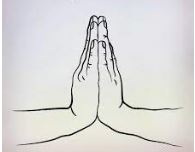 |
| Bramha | Stimulates: All five Elements- Vayu (Air), Agni (Fire), Akasha (Aether), Bhumi (Earth), and Jala (Water) | Now fold your thumb and the thumb is placed at the base of the small finger.Then remaining fingers curl over the thumb, putting pressure over the outer thumb and making a gentle fist. |  |